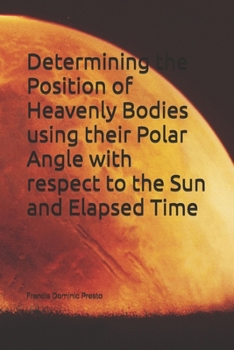Determining the Position of Heavenly Bodies using their Polar Angle with respect to the Sun and Elapsed Time
This book discusses how will a heavenly body out there, be it a planet, a moon, a star, an asteroid, a comet, etc (as long as they follow the orbit concept, one revolving around a bigger another) can have its position relative to the sun in terms of polar angle and elapsed time as the parameter. This treatise removes the unnecessary compilation of "ephemeris data", etc. and treats the motion to the most simple case, yet in an accurate manner. The solution involves the integration of the third equation of Kepler, depending on the type of orbit - elliptical, parabolic, hyperbolic, or circular. The equations has proven their use when the author had used them to pinpoint (unexpectedly, not intended that such will occur) the April 29, 2011 closest total planetary alignment, with the original solutions lost but the mother equation and the approach still intact. First publication of formulas as a student were on The Appulse - Official Newsletter of the Philippine Astronomical Society July - August 2011, pages 2 to 5, 7, and 17. A pdf document of that magazine is at https: //drive.google.com/file/d/11S6T6b1Ii_9PTYaTwJMMOsXGG7szhFkU/view. Please check https: //youtu.be/uD4izuDMUQA (Timelapse of the Future: A Journey to the End of Time) by melodysheep for a nice introduction before pursuing the serious mathematics in this book.
Format:Paperback
Language:English
ISBN:1657275310
ISBN13:9781657275317
Release Date:January 2020
Publisher:Independently Published
Length:26 Pages
Weight:0.12 lbs.
Dimensions:0.1" x 6.0" x 9.0"
Customer Reviews
0 rating





